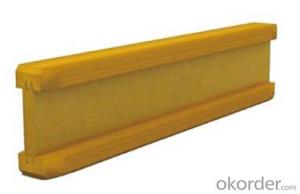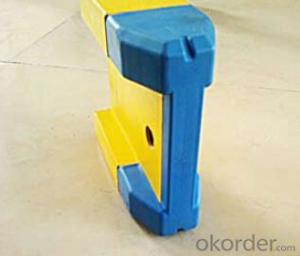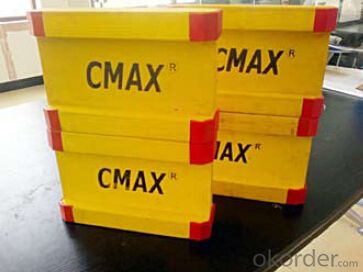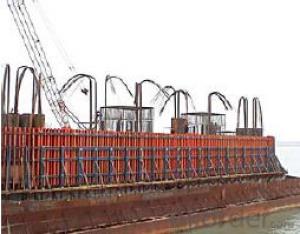Timber-beam for formwork and scaffolding system
- Loading Port:
- Tianjin
- Payment Terms:
- TT OR LC
- Min Order Qty:
- 50 m²
- Supply Capability:
- 1000 m²/month
OKorder Service Pledge
OKorder Financial Service
You Might Also Like
Characteristics:
◆ Standardized production lines.
Supply capability: 3000m/day, Lmax = 6600mm.
◆ Finger jointing of the flange and web, the strength of timber beam is highly improved.
Max. shearing force failure load:40KN
◆ Well treated to prevent from water penetration or erosion, so the service life maximally extended.
Normally, CNBM timber beam H20 can be used for 4 to 5 years, the exact using time would depend on maintenance & storage.
◆ Robust caps at the end of the girders protect against damages.
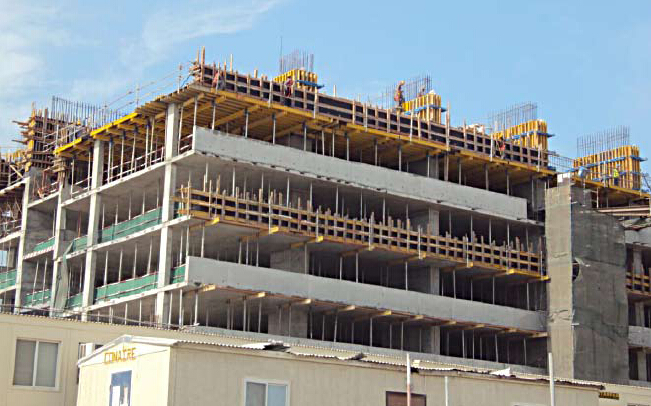
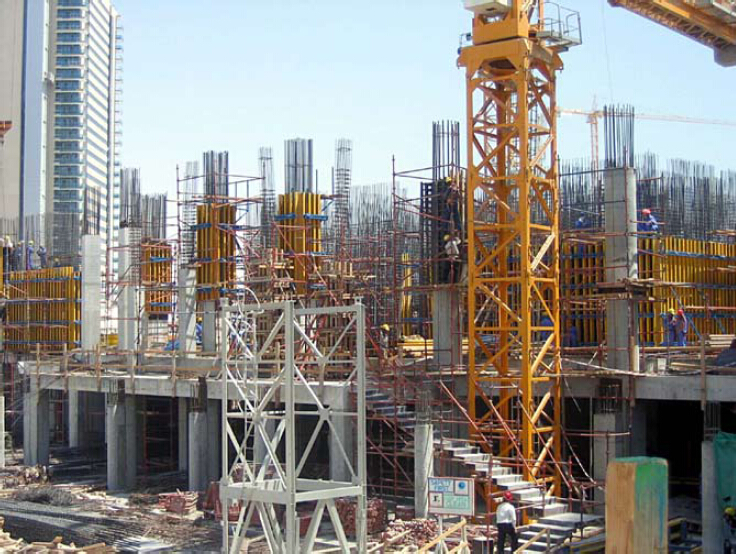
- Q: How does steel formwork contribute to the sustainability of the construction industry?
- Steel formwork contributes to the sustainability of the construction industry in several ways. Firstly, steel formwork is highly durable and long-lasting. Unlike traditional wooden formwork, which often needs to be replaced after a few uses, steel formwork can be reused multiple times, reducing the need for new materials and minimizing waste. This not only saves money for construction companies but also reduces the environmental impact of the industry by reducing the demand for timber. Secondly, steel formwork is more efficient and time-saving compared to other types of formwork. The use of steel allows for faster assembly and disassembly, reducing construction time and costs. This efficiency translates into reduced energy consumption and lower carbon emissions, thereby contributing to the sustainability of the construction process. Moreover, steel formwork offers flexibility and adaptability in design, allowing for the construction of complex structures with ease. This versatility reduces the need for additional materials and resources, as the same formwork can be used for various projects. This adaptability also minimizes construction waste, further enhancing the sustainability of the industry. Additionally, steel formwork has a high load-bearing capacity, enabling the construction of taller and stronger structures. This means that fewer materials are required to achieve the same structural integrity, reducing resource consumption and waste generation. The ability to construct more durable buildings also contributes to the long-term sustainability of the construction industry by reducing the need for frequent repairs or replacements. Lastly, steel formwork is recyclable. At the end of its lifespan, steel formwork can be easily and efficiently recycled, reducing the demand for new steel production and minimizing the environmental impact associated with its extraction and manufacturing. In conclusion, steel formwork contributes to the sustainability of the construction industry through its durability, efficiency, flexibility, load-bearing capacity, and recyclability. Its ability to reduce waste, energy consumption, and carbon emissions makes it an environmentally-friendly choice for construction projects, promoting a more sustainable and responsible construction industry.
- Q: What are the different types of supports used in steel formwork installation?
- There are several types of supports used in steel formwork installation, including adjustable steel props, timber props, soldier beams, and trusses. These supports are used to provide stability to the formwork system and ensure proper alignment and load distribution during the construction process.
- Q: Can steel formwork be used for pre-stressed concrete elements?
- Yes, steel formwork can be used for pre-stressed concrete elements. Steel formwork provides high strength and durability, making it suitable for handling the high stresses and pressures involved in the pre-stressing process. Additionally, steel formwork allows for precise shaping and alignment of pre-stressed concrete elements, ensuring accurate results.
- Q: How do steel formwork systems differ from one another?
- Steel formwork systems can differ from one another in several ways. Firstly, they can vary in terms of their design and construction. Some steel formwork systems are modular, meaning they consist of pre-assembled panels that can be easily connected and adjusted to form different shapes and sizes. Others may be custom-made for specific projects, offering more flexibility in terms of formwork design. Secondly, steel formwork systems can differ in terms of their strength and durability. Some systems are designed to withstand heavy loads and extreme conditions, making them suitable for large-scale construction projects. Others may be lighter and more portable, making them ideal for smaller projects or areas with limited access. Another factor that distinguishes steel formwork systems is their ease of use. Some systems are designed to be user-friendly, with features such as built-in handles, adjustable brackets, and easy-to-use locking mechanisms. These systems allow for quick and efficient installation and dismantling, saving time and effort on the construction site. Additionally, steel formwork systems can differ in terms of their finishing options. Some systems offer smooth and precise finishes, ideal for projects that require a high-quality surface. Others may have textured or patterned finishes, providing a decorative element to the concrete structure. Lastly, steel formwork systems can differ in terms of their cost and availability. Some systems may be more affordable and readily available, making them a popular choice for smaller projects or budget-conscious contractors. Other systems may be more expensive or require longer lead times for fabrication, but offer advanced features or customization options. Overall, the differences between steel formwork systems lie in their design, strength, ease of use, finishing options, and cost. Contractors and construction professionals should carefully evaluate these factors to select the most suitable steel formwork system for their specific project requirements.
- Q: Can steel formwork be used for projects with limited formwork transportation options?
- Projects with limited formwork transportation options can utilize steel formwork. Steel formwork is renowned for its durability, strength, and reusability, making it an excellent selection for projects that necessitate transportation over extensive distances or challenging terrains. Unlike traditional wood formwork, steel formwork can endure transportation challenges without experiencing damage or deformation. Moreover, steel formwork is lightweight in comparison to other formwork materials like concrete or timber, which facilitates transportation even in areas with restricted transportation options. The lightweight attribute of steel formwork not only reduces transportation expenses but also enables easier handling and on-site installation. Furthermore, steel formwork can be effortlessly dismantled and reassembled, making it suitable for projects that often require formwork transportation. The modular design of steel formwork allows for convenient transportation and reconfiguration, ensuring efficient transportability to various project sites as necessary. In conclusion, steel formwork is a versatile and pragmatic solution for projects with limited formwork transportation options. Its durability, lightweight nature, and ease of disassembly and reassembly make it an appropriate choice for projects that mandate formwork transportation over extensive distances or challenging terrains.
- Q: How does steel formwork handle concrete finishing and curing agents?
- Steel formwork is a highly durable and versatile material that is specifically designed to handle the concrete finishing and curing process. Due to its strength and rigidity, steel formwork provides a stable structure that ensures the concrete is poured and cured in a controlled manner. During the concrete finishing stage, steel formwork allows for the smooth and even application of various finishing agents such as troweling, brushing, or spraying. The smooth surface of steel formwork allows for the easy application and manipulation of these agents, resulting in a uniform and aesthetically pleasing finish. Additionally, steel formwork is resistant to chemical reactions with concrete curing agents. Concrete curing agents are applied to the surface of freshly poured concrete to enhance its strength, durability, and appearance. These agents can include sealers, curing compounds, or coatings. Steel formwork does not chemically react with these substances, ensuring that they can be applied and absorbed by the concrete without any negative effects on the formwork material. Moreover, steel formwork is non-absorbent, meaning it does not absorb any moisture from the curing agents or the concrete itself. This characteristic is crucial during the curing process as it allows the concrete to retain its moisture content, ensuring proper hydration and strength development. The non-absorbent nature of steel formwork also prevents any potential damage or degradation that could occur if the formwork material were to absorb moisture and expand or corrode. In summary, steel formwork is an ideal material for handling concrete finishing and curing agents due to its strength, rigidity, non-reactive nature, and non-absorbent properties. It provides a stable structure for the application of finishing agents, while also allowing for proper curing and moisture retention in the concrete.
- Q: What are the different types of joints used in steel formwork?
- There are several different types of joints commonly used in steel formwork for construction projects. These joints are designed to provide stability and ensure the proper alignment of the formwork system. 1. Butt Joint: The butt joint is the most basic type of joint used in steel formwork. It is formed by placing two formwork panels together, with their edges abutting each other. This joint is often reinforced with steel plates or angles to provide additional strength and stability. 2. Corner Joint: As the name suggests, corner joints are used to connect formwork panels at corners. These joints are typically reinforced with steel angles or brackets to ensure proper alignment and support. 3. T-Joint: T-joints are used in situations where formwork panels intersect at a perpendicular angle. This joint is formed by connecting three formwork panels together, with one panel positioned perpendicular to the other two. 4. L-Joint: L-joints are similar to T-joints, but they are used when formwork panels intersect at a 90-degree angle. This joint is formed by connecting two formwork panels together, with one panel positioned perpendicular to the other. 5. Lap Joint: Lap joints are used when long formwork panels need to be connected to create a continuous surface. This joint is formed by overlapping the edges of two panels and securing them together with bolts or clamps. 6. Hinged Joint: Hinged joints are used when formwork panels need to be adjustable or movable. This joint allows for flexibility in formwork placement and can be locked in various positions to accommodate different shapes and sizes. It is important to note that the specific type of joint used in steel formwork will depend on the requirements of the construction project, including the desired formwork system and the structural design. The selection of the appropriate joint is crucial to ensure the overall stability and strength of the formwork system.
- Q: What are the considerations when designing steel formwork for slabs with openings?
- When designing steel formwork for slabs with openings, several important considerations need to be taken into account. These include: 1. Load-bearing capacity: The formwork must be able to support the weight of the concrete, as well as any additional loads that may be placed on it during construction or use. The formwork should be designed to withstand these loads without experiencing excessive deflection or failure. 2. Durability: Steel formwork should be designed to withstand the harsh conditions of construction sites, including exposure to moisture, chemicals, and physical impact. The material chosen should be resistant to corrosion and have a high strength-to-weight ratio. 3. Flexibility and adjustability: Since slabs with openings often have irregular shapes and sizes, the formwork should be designed to be flexible and adjustable. This allows for easy customization and ensures a precise fit for the openings. 4. Support for reinforcement: The formwork should provide adequate support for the reinforcement bars or mesh used within the slab. It should be designed to accommodate the placement and spacing of these reinforcements, ensuring proper concrete cover and structural integrity. 5. Ease of assembly and disassembly: The formwork system should be designed for easy assembly and disassembly, as it needs to be repeatedly used for multiple slabs with openings. The components should be lightweight and easily maneuverable, allowing for efficient construction and reduced labor costs. 6. Safety: Safety is of utmost importance in the design of steel formwork. The formwork should be designed to prevent accidents, such as slipping or collapsing, during assembly, concrete pouring, and removal. Adequate safety measures, such as guardrails and non-slip surfaces, should be incorporated into the design. 7. Cost-effectiveness: The design should aim to minimize material and labor costs while still ensuring the required strength and durability. Efficient use of materials and standardization of components can help reduce overall costs. 8. Compatibility with other construction systems: The formwork should be compatible with other construction systems, such as scaffolding or shoring, to ensure proper integration and coordination during the construction process. By considering these factors, designers can create steel formwork systems that are safe, durable, cost-effective, and efficient for slabs with openings.
- Q: What is the 86 series steel formwork
- If a large concrete pouring for the interruption or delay the closing fast and easy net is a kind of ideal material, it is a kind of preparation activities can form any emergency terminated required. The construction can be quickly restored, without dismantling work for temporary sealing end. Because of the use of quick and easy closing network can quickly build not included in the plan terminated, as a contingency measure. Customers can before large casting at the site to prepare some available will be attached, with concrete formwork for pouring the easy days after creating the ideal surface cementation.
- Q: Can steel formwork be used in tunnel construction projects?
- Certainly! Tunnel construction projects can indeed utilize steel formwork. When it comes to tunnel construction, steel formwork is widely preferred because of its durability, strength, and ability to be reused. This type of formwork offers a strong and reliable framework for pouring concrete, aiding in achieving precise and accurate dimensions in tunnel construction. Moreover, steel formwork is capable of withstanding the pressures exerted by the surrounding soil and the weight of the concrete, which guarantees the stability and safety of the tunnel structure. In addition to these advantages, steel formwork is resistant to corrosion and boasts a longer lifespan compared to other formwork options, making it an excellent choice for tunnel construction projects that require longevity.
Send your message to us
Timber-beam for formwork and scaffolding system
- Loading Port:
- Tianjin
- Payment Terms:
- TT OR LC
- Min Order Qty:
- 50 m²
- Supply Capability:
- 1000 m²/month
OKorder Service Pledge
OKorder Financial Service
Similar products
Hot products
Hot Searches
Related keywords
